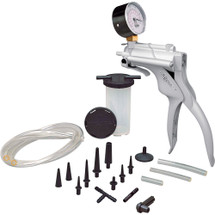Posted by Support Staff on 18th Apr 2017
How to bleed the ABS Brake System. ABS Brakes WITHOUT Traction Control.
Notice: Use only DOT 3 brake fluid from a clean, sealed container. Do not use any fluid from a container which is wet with water. Do not use DOT 5 silicone brake fluid. Improper brake fluid, mineral oil or water in the fluid may cause the brake fluid to boil or the rubber components to deteriorate. Keep all fluid containers capped to prevent contamination.
Important: In the following procedure, use a suitable container or shop cloths in order to catch and prevent the brake fluid from contacting any painted surfaces.
- Clean the brake fluid reservoir cover and the surrounding area.
- Remove the brake fluid reservoir cover.
- Inspect the brake fluid level. Fill the reservoir to the correct level if necessary.
- Install the brake fluid reservoir cover.
- Prime the ABS brake modulator. Use the following procedure:
| 5.1. | Attach a clear plastic bleeder hose to the rearward bleeder valve on the ABS hydraulic modulator. |
Submerge the opposite hose end in a clean container partially filled with clean brake fluid.
| 5.2. | Slowly open the rearward bleeder valve one half to one full turn. |
| 5.3. | Depress the brake pedal. Hold the pedal until the fluid begins to flow. |
| 5.4. | Close the valve. Release the brake pedal. |
| 5.5. | Repeat the previous three steps until air bubbles are no longer present. |
Important: Once the fluid is visibly flowing from both ABS hydraulic modulator bleeder valves, the ABS brake modulator is sufficiently full of fluid. However, it may not be completely purged of air. At this point, move to the wheel brakes and bleed the brakes. This ensures that the lowest points in the system are completely free of air. The ABS brake modulator may then be purged of any remaining air.
| 5.6. | Relocate the bleeder hose on the forward ABS hydraulic modulator bleeder valve. Submerge the opposite hose end in a clean container partially filled with clean brake fluid. Then, repeat the previous four steps. |
- Remove the brake fluid reservoir cover.
- Inspect the brake fluid level in the reservoir. Fill the reservoir to the correct level, if necessary.
- Install the brake fluid reservoir cover.
- Raise the vehicle. Support the vehicle.
- The bleed sequence is as follows: right rear, left front, right front, left rear.
- Bleed the wheel brakes in the sequence shown above. Use the following procedure:
- Attach a clear plastic bleeder hose to the bleeder valve at each wheel.Submerge the opposite hose end in a clean container partially filled with clean brake fluid.
- Open the bleeder valve.
- Slowly depress the brake pedal.
- Close the valve. Slowly release the brake pedal.
- Wait 5 seconds.
- Repeat the previous four steps until the brake pedal feels firm and no air bubbles are visible in the bleeder hose. Tap lightly on the caliper or braking plate using a rubber mallet in order to assist in freeing any trapped air.
- Lower the vehicle.
- Remove the brake fluid reservoir cover.
- Inspect the brake fluid level in the reservoir. Fill the reservoir to the correct level if necessary.
- Install the brake fluid reservoir cover.
- Bleed the ABS hydraulic modulator. Use the following procedure:
| 22.1. | Attach a clear plastic bleeder hose to the rearward bleeder valve on the ABS hydraulic modulator. |
Submerge the opposite hose end in a clean container partially filled with clean brake fluid.
| 22.2. | Depress the brake pedal with moderate force. |
| 22.3. | Slowly open the rearward bleeder valve one half to one full turn. Allow the fluid to flow. |
| 22.4. | Close the valve. Slowly release the brake pedal. |
| 22.5. | Wait 5 seconds. |
| 22.6. | Repeat the previous four steps until air bubbles are no longer visible in the bleeder hose. |
| 22.7. | Relocate the bleeder hose on the forward ABS hydraulic modulator bleeder valve. |
Submerge the opposite hose end in a clean container partially filled with clean brake fluid.
Then, repeat the previous five steps.
Tighten the ABS hydraulic modulator bleeder valves to 9 Nm (80 inch lbs.) .
- Remove the brake fluid reservoir cover.
- Inspect the brake fluid level in the reservoir. Fill the reservoir to the correct level if necessary.
- Install the brake fluid reservoir cover.
- Turn the ignition switch to the RUN position. Apply the brake pedal with moderate force and hold. Note the pedal travel and feel.
| 26.1. | If the pedal feels firm and constant and pedal travel is not excessive, start the engine. |
| 26.2. | With the engine running, recheck the pedal travel. |
| 26.3. | If the pedal still feels firm and constant and pedal travel is not excessive, road test the vehicle. |
Make several normal (non-ABS) stops from a moderate speed in order to ensure proper brake system function. Allow adequate cooling time between stops.
- If pedal feel is soft or has excessive travel either initially or after starting the engine, repeat previous steps until firm pedal is attained.
- Road test the vehicle. Make several normal (non-ABS) stops from a moderate speed in order to ensure proper brake system function. Allow adequate cooling time between stops.




